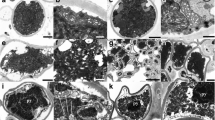Summary
The ultrastructure of the phycobionts fromRhizocarpon geographicum, Umbilicaria pustulata andRamalina maciformis is described from thalli which were fixed short time after collecting them and after different periods of dryness up to four years. By demonstrating only little changes in the phycobiont ultrastructure of dry thalli their well known resistance to dryness could be confirmed. Rewetting the lichens induced the appearence of starch and some other alterations in the phycobiont ultrastructure which depend of the rewetting conditions.
Zusammenfassung
Rhizocarpon geographicum, Umbilicaria pustulata undRamalina maciformis wurden für elektronenmikroskopische Untersuchungen ihrer Phycobionten kurze Zeit nach dem Sammeln dieser Flechten und nach verschieden langen Trockenperioden bis zu 4 Jahren fixiert. Die beobachteten geringen Änderungen in den Phycobionten nach langer Trockenzeit bestätigen die große Trockenresistenz der Flechten. Eine erneute Befeuchtung der Flechten führt im allgemeinen zum Auftreten von Stärke in den Phycobionten Chromatophoren und zu einigen anderen Änderungen, die von der Temperatur und der Belichtung während der Befeuchtung abhängen.
Similar content being viewed by others
Literatur
Ascaso, C., andJ. Galvan, 1976: The ultrastructure of the symbionts ofRhizocarpon geographicum, Parmelia conspersa andUmbilicaria pustulata growing under dryness conditions. Protoplasma87, 409–418.
Brown, R. M., andR. Wilson, 1968: Electron microscopy of the lichenPhyscia aipolia (Erh.) Nyl. J. Phycology4, 230–240.
Dodge, J. D., 1973: The fine structure of algal cells. London and New York: Academic Press.
Hayes, T. L., F. T. Lindgren, andJ. W. Gofman, 1963: A quantitative determination of the osmium tetroxid — lipoprotein interaction. J. Cell Biol.19, 251–255.
Jacobs, J. B., andV. Ahmadjian, 1969: The ultrastructure of lichen. I. A general survey. J. Phycol.5, 227–240.
Lange, O. L., 1953: Hitze- und Trockenresistenz der Flechten in Beziehung zu ihrer Verbreitung. Flora140, 39–97.
—, 1969: Experimentell-ökologische Untersuchungen an Flechten der Negev-Wüste. Flora158, 324–359.
—,E.-D. Schulze, L. Kappen, U. Buschbom, andM. Evenari, 1975: Adaptations of desert lichens to drought and extreme temperatures. In: Environmental physiology of desert organisms (Hadley, N. F., ed.). Stroudburg, Pennsylvania: Dowden, Hutchinson and Ross, Inc.
Pearson, L. C., 1970: Varying environmental factors in order to grow intact lichens under laboratory conditions Amer. J. Bot.57, 659–664.
Peveling, E., 1969: Elektronenoptische Untersuchungen an Flechten. II. Die Feinstruktur von Trebouxia-Phycobionten. Planta87, 69–85.
—, 1970: Das Vorkommen von Stärke in Chlorophyceen-Phycobionten. Planta93, 82–85.
—, 1974: Biogenesis of the cell organelles during the differentiation of the lichen thallus. Portugalia Acta Biologica Ser. A, vol.XIV, 357–368.
—, 1976: Investigations into the ultrastructure of lichens. In: Lichenology: Progress and Problems (Brown, D. H., D. L. Hawsworth, andR. H. Bailey, eds.), pp. 17–26. London-New York: Academic Press.
—, andM. Galun, 1976: Elektron-microscopical studies on the phycobiontCoccomyxa Schmidle. New Phytol.77, 713–718.
Reynolds, E. S., 1963: The use of lead citrate at high pH as an electron-opaque stain in electron microscopy. J. Cell Biol.17, 208–212.
Ried, A., 1960 a: Thallusbau und Assimilationshaushalt von Laub- und Krustenflechten. Biol. Zentralblatt79, 129–151.
—, 1960 b: Nachwirkungen der Entquellung auf den Gaswechsel von Krustenflechten. Biol. Zentralblatt79, 657–678.
—, 1960 c: Stoffwechsel und Verbreitungsgrenzen von Flechten. II. Wasser- und Assimilationshaushalt, Entquellungs- und Submersionsresistenz von Krustenflechten benachbarter Standorte. Flora149, 345–385.
Rogers, R. W., 1971: Distribution of the lichenChondropsis semiviridis in relation to its heat and drought resistance. New Phytol.70, 1060–1077.
Spurr, A. R., 1969: A low epoxy resin embedding medium for electron microscopy. J. Ultrastruct. Res.26, 31–43.
Author information
Authors and Affiliations
Additional information
Mit Unterstützung der Deutschen Forschungsgemeinschaft.
Rights and permissions
About this article
Cite this article
Peveling, E. Die Ultrastruktur einiger Flechten nach langen Trockenzeiten. Protoplasma 92, 129–136 (1977). https://doi.org/10.1007/BF01280205
Received:
Issue Date:
DOI: https://doi.org/10.1007/BF01280205




